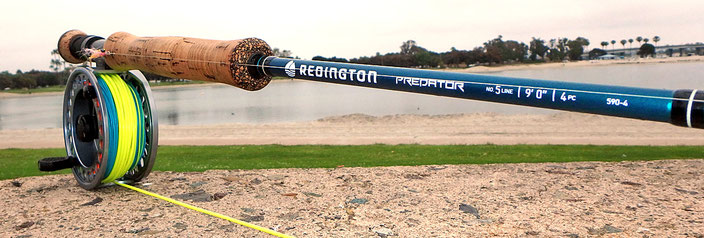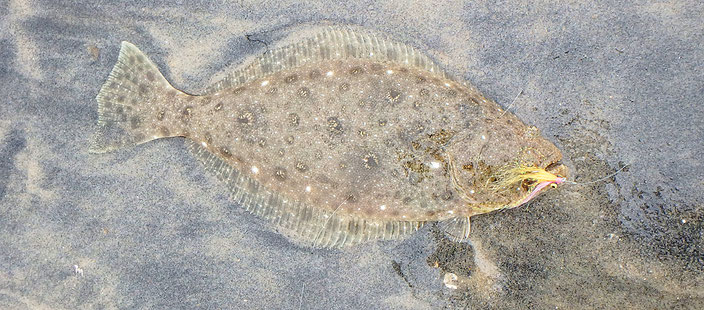Text and images by Craig Smith

Throughout the saltwater fly fishing community a 9 foot 8 weight rod is usually the most commonly recommended starting rod. That is a great choice that will be useful for a wide range of conditions. However, in our Southern California bays and estuaries, the vast majority of fish caught will be less than two pounds in weight and often less than one pound and not as much fun when caught with an 8 weight rod compared to a lighter rod. Trout sized gear will often do quite nicely when pursuing our bay and estuary fish.
Many local anglers ply the local protected salty waters with 6 or 7 weight rods but some even enjoy lighter rods. I know a couple who even go as light as a 3 weight rod. Because I like to use a wide range of flies of different sizes and fish the water column from the surface down to about 15 feet deep I want to be able to use a selection of readily available fly lines. I also want a rod to have enough backbone to handle a five pound shortfin corvina or a 10 pound halibut. So I have settled on a 5 weight rod as the lightest rod I commonly fish for in our local saltwater venues.
Just about any 5 weight rod could be used, including fiberglass and bamboo sticks, but I prefer something that is built with corrosion resistant components and I strongly prefer that the rod has a fighting butt. Those requirements eliminate most manufactured 5 weight models as options. Here at Stroud Tackle, when we are going lightweight for saltwater action we prefer the Redington Predator 590-4. Over that last two years we have put in over 60 days on San Diego Bay and Mission Bay with this model and it has rewarded us with plenty of angling enjoyment of catches of spotted bay bass, bonito, mackerel, shortfin corvina, halibut, croaker, corbina, bonefish, and other species.
The Predator series graphite blanks are an attractive blue color that really pops in bright sunlight but isn’t overly reflective. The cork grip is fairly comfortable even for anglers with small hands. The cork isn’t the highest quality that you will find on rods that cost twice as much but it doesn’t have too much filler either. After two years of usage no pits have developed. The reel seat is black anodized machined aluminum and has two locking rings that hold reels securely. I personally dislike hook keepers on rods - I have cut my hands either on a keeper it self or a fly hooked into the keeper on many rods over the years - but the Predator’s reel seat has a nifty built in hook keeper. Well, actually two. On each side of the reel seat where it is inserted into the back of the cork handle, is a recessed slot that you can slip a hook point into. Don’t worry, the slot is completely enclosed in aluminum so the cork handle will not be damaged. This is a feature I first encountered on Sage RPLXi rods 20 years ago. I don’t know why this design is not more commonly used. The great thing about this feature is that the hook point of a fly is completely covered and your fingers or anything else the point might snag on is protected while you are not actually fishing. The unusual feature for a 5 weight rod is a small fighting butt tipped with a rubberized cork that is attractive and durable.
So we have covered cosmetics and key components of the rod; but, how does it perform? Well, I wouldn’t be writing this if I didn’t think it was up to our local fishing, and a lot of other fishing too. The rod is a bit heavier than most 5 weight rods that are designed with trout in mind, yet at 3.8 ounces is actually lighter than some lower cost models that are on the market. It is also a bit heavier than some of the lightest 6, 7, and 8 weight rods that are available. However, when actually fishing, the rod does not feel particularly heavy and I find it enjoyable to cast all day. The rod casts quite nicely with a standard WF-5-F fly line at the 40 to 80 foot distances we usually target when fishing it. When fishing the local bays we are typically casting weighted flies including Clouser Minnows in sizes 6, 4 and 2 using intermediate or sinking lines. The Predator 590-4 handles a 150 or 200 grain integrated shooting taper quite nicely and even does well with the lighter Teeny T-130 line. Our favorite sinking line for our local conditions is the Rio Avid Trout 150 grain 24 foot sink tip line for covering depths from about 6 to 15 feet and the Rio Mainstream WF-5-I or Intouch Outbound Short WF5F/I for shallower depths. For topwater action with small poppers or crease flies or for action in calm conditions in shallow water we like the Outbound Short WF5F or Rio Grand, or to save a few dollars, a Mainstream WF-6-F. These lines are all listed as freshwater lines on Rio’s website but the work just fine in salty environments.
I haven’t found the rod to be as accurate in my hand as some of the best trout rods out there; but, accuracy has been more than adequate for the bays where, to be honest, most of the time we are just casting to an area. This rod would not be my first choice for pinpoint short range casts of dry flies to rising trout; however I have fished in marinas around moored boats and consistently put casts right up next to boats and docks, and even under docks. I have also used this rod to sight cast to corbina cruising the shallows of Mission Bay and put the fly where I wanted it. Redington’s marketing material describe this rod as having an “intuitive fast action.” I have no idea what that phrase really means. The rod does have a fast action but it isn’t a broomstick and there are many other 5 weight rods on the market that seem to me to have an even faster/stiffer action. With the Predator 590-4 I find the top section of the rod to be neither too stiff nor too soft; it is just right to handle a wide variety for floating and sinking lines and suitably protects the 8, 10, and 12 pound test tippets we typically use with it. You could fish lighter tippet if necessary.
The Predator has enough power in the butt section to deal with just about anything you would intentionally target with it yet has plenty of reserve for that unexpected oversized catch. We have brought to the net in shallow water some bat rays that were over 10 lbs.
The Predator is constructed with corrosion resistant components but isn’t just a saltwater rod. It works quite well in freshwater too. We have used this rod on local lakes for largemouth bass, panfish, trout, and carp with the same lines we recommend for saltwater action. This is also a rod to consider for casting streamers and buggers for trout in lakes and rivers. So while this rod isn’t the perfect rod for every situation you may consider using a 5 weight, we feel that it is an excellent choice many situations you have considered and even some you have not thought of.
The Redington Predator 590-4 currently retails for $299.99 (update: price increase to $349.99 for 2022 - well still think this a a good value) and is worthy of consideration for light saltwater work or if you desire a 5 weight rod with a fighting butt for any reason. We have sure had a lot of fun with it.

